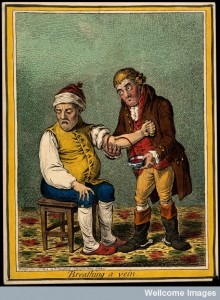By Lisa Smith (W&M Regular Contributor)
In 1780, physician M. Carrere wrote a letter to the French Royal Society of Medicine describing the unusual case of a twenty-five year old miller, Jacques Sola, who bled monthly from his right little finger. Sola became ill with dysentery and peripneumonia in 1764. The cause? Sola’s blood flow had been blocked when he stayed too long in the shadow of a windmill. Carrere cured Sola by bleeding him to re-start his ‘evacuation’.
Two years later Carrere treated Sola for a bloody cough, again caused by the suppression of Sola’s ordinary bleeding. Carrere had since moved away, but now wondered if Sola still had regular flows, or if there was ‘a fixed time for their cessation’ as in women.
Menstruation wasn’t understood as specifically connected to reproduction until the nineteenth century. It was one of many indications of female fertility, but all were tied to a woman’s overall health. In the Middle Ages, menstruation was seen as poisonous, but eighteenth-century physicians saw it as nature’s way of purging women’s surplus blood (plethora) that developed throughout the month. When normal menstruation stopped, whether by pregnancy, fright or emotional imbalance, the blood might force atypical routes out of the body. Unrelieved plethora clogged up the body, causing disease.
Since men sweat, they didn’t ordinarily develop plethora, although men who were sedentary or ate too much might – like scholars and clergymen. Some plethoric men bled periodically and regularly: by the nose (adolescence), lungs (young men), haemorrhoids (middle-age) and urine (old age). Men and women whose bodies didn’t self-regulate needed surgical bleeding to prevent or cure illness.
Physicians and surgeons in seventeenth- and eighteenth-century Europe widely discussed similar cases of ‘menstruating men’. The sexed bodies that we see today as being self-evident were ambiguously understood in the past when knowledge was observational: why wouldn’t men and women have similar flows?
But throughout the eighteenth century such tales were increasingly rare as medical men began to see male and female bodies as distinct rather than parallel.
Lisa Smith is an Associate Professor of History at the University of Saskatchewan. She writes on gender, family, and health care in England and France (ca. 1600-1800). She discusses this case and others in “The Body Embarrassed? Rethinking the Leaky Male Body in Eighteenth-Century England and France”, Gender and History 23, 1 (2011): 26-46.

